Indianwood’s Old Course has been the site of many big championships, including a pair of US Women’s Opens and a US Senior Open. For many years, it was one of the most highly regarded courses in the state, both due to its championship pedigree and what is, for Michigan, a very unusual but outstanding piece of land: mostly treeless and hilly, with long grass between the holes, giving a look a bit like Shinnacock Hills or maybe Prairie Dunes. I don’t know if this was the case before the 80s marketing strategy of treeless courses as ‘links-like,’ but the club has also given itself a bit of a Scottish branding, with a bagpiper as a logo.
But the course has kind of fallen off the radar of top Michigan golf courses in the last 20 years, perhaps ignored as the hype has built around top new public courses like The Loop and Arcadia Bluffs South and the renovation of older courses like Franklin Hills and Meadowbrook. The most recent Senior Open was only in 2012, but I haven’t heard anything about this course being under consideration for further large tournaments.
And after seeing the first few holes, it’s easy to see to see some of the reason why this course hasn’t drawn the attention that it once did: the current presentation is very much in line with the ‘old’ school of thought on how to present a course for championships. The fairways have been narrowed to well inside their original margins between the bunkers. The greens have also shrunk. Like the clubhouse, the course is looking a bit weary for age and could use some of the freshening that so many classic courses—including many in the Detroit area—have received in recent years.
But even considering the suboptimal presentation, this is an excellent course. It must still be one of the top 15 courses in the state. Although aesthetically they have very little in common, it reminded me a lot of RTJ Sr.’s The Dunes in Myrtle Beach in that it’s just a consistently demanding test of golf. You must drive the ball straight because there are often bunkers on both sides of the fairway and you must hit high, relatively soft iron shots. This is a serious ball strikers course, to which the course rating of 74.6 from the <6,900 yard tips on a par of 70 (!) attests. Except the somewhat awkward ninth drive and the kind-of silly ~20,000 sq. ft. last green, the holes are very sound, if not often spectacular. I’ve come to appreciate courses like this more over the years, even if they don’t require a great deal of strategy. Plus, the Old Course is on one of the prettiest and most interesting pieces of land in the state.
So I think that the Old is still a real winner and deserves some of its attention back. While the greens are not among the more interesting sets that you’ll see, it has one of my favorite sets of bunkers ever, at least from a shaping perspective. There are a few too many of them, but the relatively flat-bottomed pits and their steep slopes are some of the best looking bunkers that I’ve seen. I think that they’re almost the perfect-looking set of bunkers for the site.
The first is one of only two par 5s on the Old Course and it sets the tone right away: a drive out into a field, but still narrow because of bunkers left and right. Like most holes here, you just need to hit the ball straight. The fairway drops into a valley about 100 yards short of the green and you’ll have a largely blind shot if you hit it there. Unless you can go for the green, it’s probably best to lay back.
But the course has kind of fallen off the radar of top Michigan golf courses in the last 20 years, perhaps ignored as the hype has built around top new public courses like The Loop and Arcadia Bluffs South and the renovation of older courses like Franklin Hills and Meadowbrook. The most recent Senior Open was only in 2012, but I haven’t heard anything about this course being under consideration for further large tournaments.
And after seeing the first few holes, it’s easy to see to see some of the reason why this course hasn’t drawn the attention that it once did: the current presentation is very much in line with the ‘old’ school of thought on how to present a course for championships. The fairways have been narrowed to well inside their original margins between the bunkers. The greens have also shrunk. Like the clubhouse, the course is looking a bit weary for age and could use some of the freshening that so many classic courses—including many in the Detroit area—have received in recent years.
But even considering the suboptimal presentation, this is an excellent course. It must still be one of the top 15 courses in the state. Although aesthetically they have very little in common, it reminded me a lot of RTJ Sr.’s The Dunes in Myrtle Beach in that it’s just a consistently demanding test of golf. You must drive the ball straight because there are often bunkers on both sides of the fairway and you must hit high, relatively soft iron shots. This is a serious ball strikers course, to which the course rating of 74.6 from the <6,900 yard tips on a par of 70 (!) attests. Except the somewhat awkward ninth drive and the kind-of silly ~20,000 sq. ft. last green, the holes are very sound, if not often spectacular. I’ve come to appreciate courses like this more over the years, even if they don’t require a great deal of strategy. Plus, the Old Course is on one of the prettiest and most interesting pieces of land in the state.
So I think that the Old is still a real winner and deserves some of its attention back. While the greens are not among the more interesting sets that you’ll see, it has one of my favorite sets of bunkers ever, at least from a shaping perspective. There are a few too many of them, but the relatively flat-bottomed pits and their steep slopes are some of the best looking bunkers that I’ve seen. I think that they’re almost the perfect-looking set of bunkers for the site.
The first is one of only two par 5s on the Old Course and it sets the tone right away: a drive out into a field, but still narrow because of bunkers left and right. Like most holes here, you just need to hit the ball straight. The fairway drops into a valley about 100 yards short of the green and you’ll have a largely blind shot if you hit it there. Unless you can go for the green, it’s probably best to lay back.
The second is a very difficult ~390 yard par 4 with bunkers pinching the fairway at about 230. It’s not a bad idea to lay up here but you have to be careful—I tried to lay up and my 2-hybrid still ran into the right fairway bunker. The hole widens past this bunker and it might be better just to try an carry past it…although you really don’t want to miss right.
The terrain on the approach and the way that the green sits simply on the ground are both beautiful. This is one of several holes where the mowing lines on and around the green could be expanded, but it’s still a very good hole as is.
The terrain on the approach and the way that the green sits simply on the ground are both beautiful. This is one of several holes where the mowing lines on and around the green could be expanded, but it’s still a very good hole as is.
Three is a ~180 yard par 3 over a valley with a three-tiered back-to-front sloping green that sits at about a 60 degree angle from the main tees. From the back tee however, left of the second green, you play right down the angle of the green. It’s a good hole either way, but I think that it’s a bit more interesting with the angle from the regular ~165 yard tees.
The long par 4 fourth has been the source of some grumbling as it falls over a beautiful piece of land but where the fairway has clearly shrunk from its original margins. The narrowed mowing lines around the landing area don’t bother me as much as the shrunken mowing lines on and around this green, which I’d say is the one thing on the course that’s under-performing most relative to its potential.
It’s very difficult to get far enough off the tee to be able to see anything but the top of the flagstick on the approach. So everyone is dealing with a blind approach shot, but the approach is perfectly designed for this, with a broad fairway leading into a generous, back-to-front sloping green. Unfortunately both the approach fairway and the green itself have shrunk. This would be an incredible looking hole if they widened these sets of mowing lines and would make it easier to play the run-up shot that most will need to play from such a long distance off a sidehill lie.
The fifth is the second of four excellent par 3s. It features two very deep bunkers at its front-left and right. We’ll see after a few more holes that this green is something of a template on this course; sort-of a thumbprint in the front-middle with a higher second-tier around the back. Almost all of the greens tend to funnel from the sides and back into the middle and this lack of variety is a drawback.
Six and seven are two flat, straight par 4s. Six is about 465 yards and very difficult. The green opens from the right and so you’re best to be on that side of the fairway. The seventh green opens from the left and so you’re best approach from that side. And if you hook it all the way over into the sixth fairway like I did, that also isn’t too bad.
Eight is a bit of a bland uphill drive but it’s a very difficult second shot thanks to the small hilltop green. It’s really crucial that you hit a solid iron shot here.
I had been warned by a few people that the dogleg right short par 4 ninth was weird. It is. You drive over a valley to a diagonal ridge that runs off to the right toward the green. The first issue is that you need to carry it at least 200 yards to reach the top of the ridge. But you also need to keep it short of 240 or you can run through the fairway down a steep hill. Longer hitters will be tempted to hit driver across the corner and I’m not sure that that’s a bad idea given the lack of landing area in the lay up zone.
The approach is downhill to an absurdly back-to-front sloping green. Don’t be long and bank one off the clubhouse…like I did.
Ten is a fairly simple short par 4 where you just layup short of a pond at about 250 and pitch on to another steep back-to-front sloping green. Not the most interesting hole, but the shows off nicely the excellent shaping of the bunkers and the green complex.
The par 4 eleventh offers another choice of angles off the tee: a semi-blind drive over a bunker to a fairway that turns right but slopes left from the 400 yard back tees or straight up the chute from the ~360 yard middle tees. It’s a better choice than the third because this time, the back tees have the more difficult angle. The approach is similar to several others, uphill to a plateau green fronted by deep bunkers.
From the back tees, the 490 yard twelfth might be the hardest par 4 that I’ve ever seen. It’s a bit absurd because at 250 there’s a series of bunkers on the right and a pond at the edge of the fairway left. It’s one of the most difficult driving holes that I’ve ever seen. Even if you hit the fairway, the approach is to a green that’s completely fronted by bunkers, so leaving almost no way to run the ball on. It’s best to just lay up off the tee and play this as a par 5.
The par 3s are highlights on the Old Course and the 215 yard thirteenth might be my favorite of the bunch. It plays to what looks like a punchbowl green, but—unlike every other green on this course—it actually slopes out to the back left. That makes it pretty tough; unless you can hit something high that lands in the front, it’s hard to hold the green. It’s also hard to run one up here because of the slope short.
Thirteen is a pretty uninteresting long par 4 to another table top green. The holes on this part of the property (6-8, 14) are a weakness of the course although they’re still quite demanding and at least not gimmicky.
The rolling par 5 fifteenth is a bit more interesting. It shouldn’t be hard to carry the bunker on the right (although I didn’t…) and if you can get it to about the 280 mark from the tips, you can catch a downslope and run well downhill. The second shot is tough as the black locust tree on the right is getting too big and encroaching too much into the fairway. The green sits past it at the top of the hill.
The worst walk on the course is from the fifteenth green to the sixteenth tee; it’s about 175 yards. But it’s worth it because the long par 4 sixteenth is one of the course’s best and the beginning of an excellent three-hole closing stretch. The drive is through a chute uphill and you need about 240 yards to reach the plateau. The hole turns right around a cluster of fairway bunkers at about 275 and the approach is over beautiful, rolling land to a surprisingly small green. The best miss here is in the ample fairway short because the green is very narrow and the bunkers on both sides are, as usual, very deep.
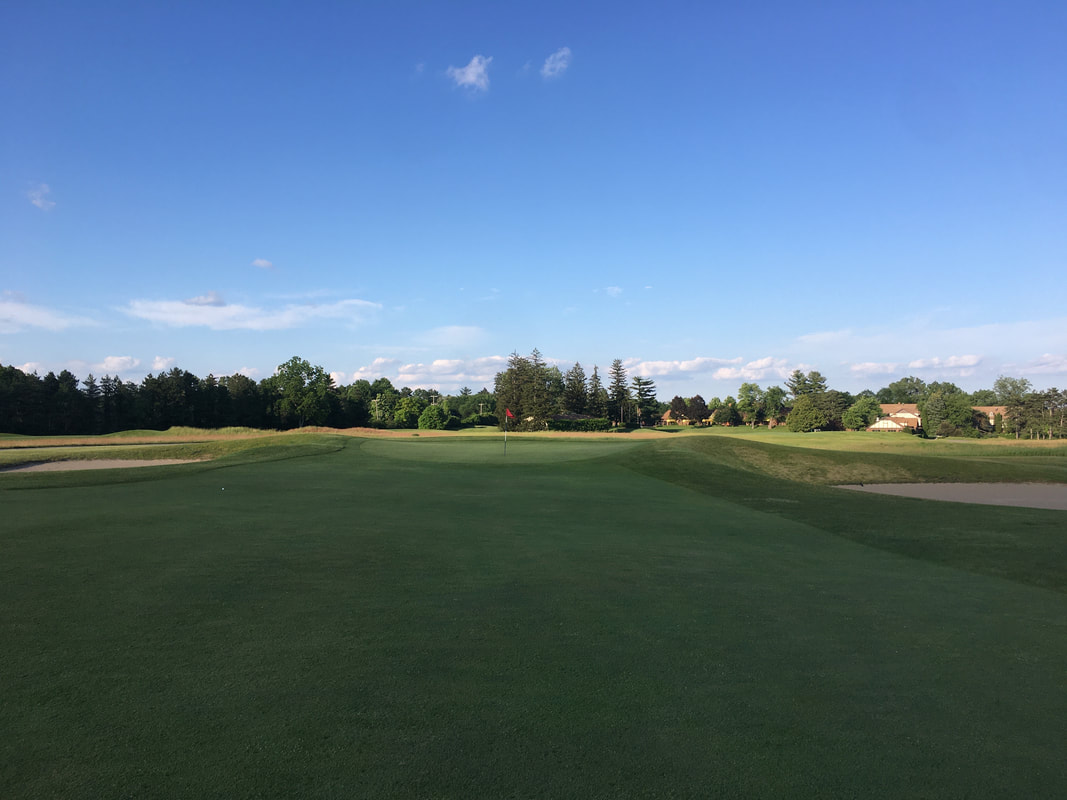
The green is very narrow but the entrance is wide so you take on a lot of risk if you play deep into the green. But the shorter hitter won't have much trouble if they're reasonably accurate. This is a great way to make a long par 4 very demanding for the low handicapper yet playable for everyone else. Excellent hole.
I thought that the par 3 seventeenth was just beautiful. The green is sited at the far end of a ridge, so you really don’t want to go long or left. We have another variation on the thumbprint green, although this one is a bit different with the low area being at the front-right and the high area around to the left. Again, short is a good miss here.
I don’t know if it was like this originally or the club has altered it over the years, but the eighteenth is wild. Wild and very good, but with some flaws. In principle, this is a great driving hole, requiring about a 250 carry to reach the plateau up the left and where a long hitter can shorten the hole by a bit if the can carry it about that same distance over a mess of bunkers on the inside of the dogleg.
But while it’s still a good drive, it’s too difficult at the moment because the fairway fills only about half its margin and it’s extremely narrow, making it difficult to run the ball up the hill. Mowing the fairway out on the left would help. I also think it would help if they lost one or two of the bunkers that cut into the fairway on the right to give a bit more width to try and skirt the rest of them. As is, the drive is very punishing for short hitters and I’d recommend moving up to a set of tees from where the carry to the top of the hill is manageable.
But while it’s still a good drive, it’s too difficult at the moment because the fairway fills only about half its margin and it’s extremely narrow, making it difficult to run the ball up the hill. Mowing the fairway out on the left would help. I also think it would help if they lost one or two of the bunkers that cut into the fairway on the right to give a bit more width to try and skirt the rest of them. As is, the drive is very punishing for short hitters and I’d recommend moving up to a set of tees from where the carry to the top of the hill is manageable.

It's another great looking drive on eighteen, but awfully difficult if you can't carry the bunkers. And even if you can, you have to carry another 5-10 yards of rough to reach the fairway. More than any other, this hole could use expanded fairway mowing lines. I also don't think it'd hurt to fill in the bunker that cuts furthest into the fairway. The rest would still form a tough diagonal carry for long hitters.
The approach over rolling hills to the massive green site is a beauty, but the green, probably the size of half of the rest of the greens put together, is absurd. Not in a bad way though—the contours on this monstrous green are some of the best that you’ll ever see. Although I wouldn’t want every green on the course to be this size (the greenskeeper certainly wouldn’t either), I wish that some of the other greens had this wonderful, free-flowing contouring. It’s hard to get the ball close to the pin here but it’s a lot of fun to putt when you fail.
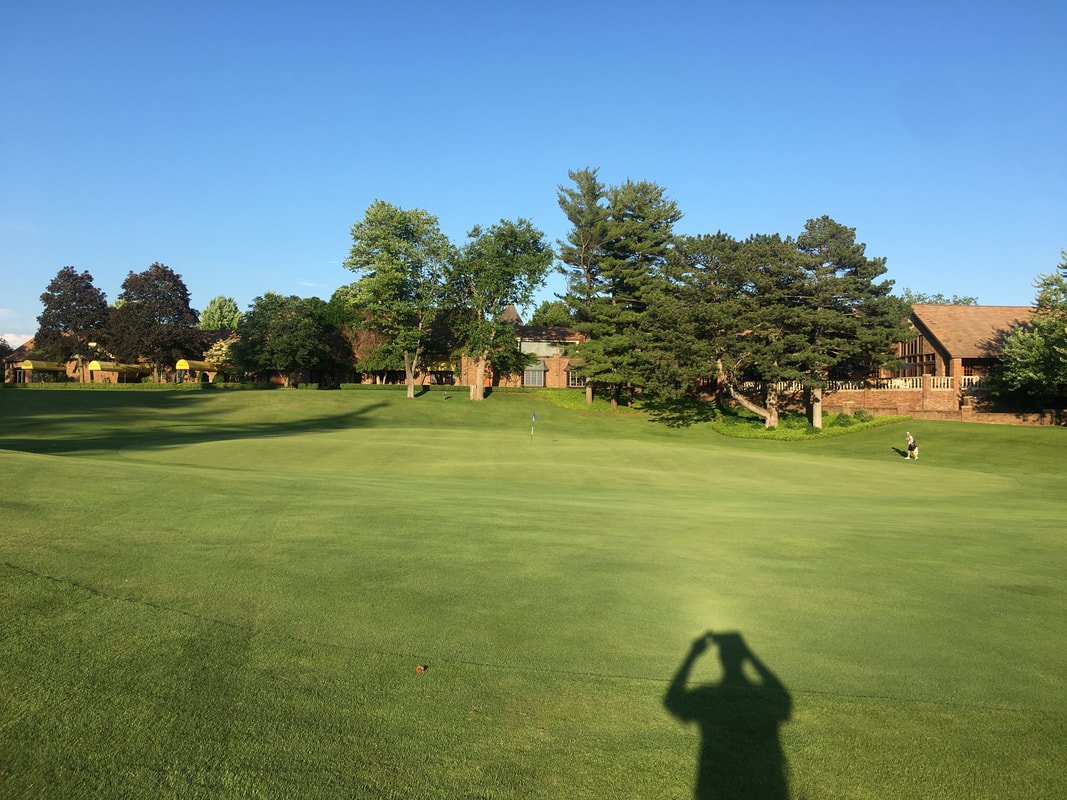
The spectacular-but-absurd eighteenth green measures about 50 yards deep by 45 yards wide per Google Earth...meaning that it's about 16,000 square feet! I wish that some of the other greens had this kind of interior contour, although they wouldn't even need to be half the size (Most are probably less than 1/3 this size).
I’d been wanting to play the Old Course for at least 20 years and it was nice to have the opportunity. I played Indianwood’s New Course back in 2002 and that was…interesting. I described it to someone as a course with multiple personality disorder; one hole it thinks it’s Pine Valley, then a resort course in northern Michigan, then Pete Dye, then St. Andrews. It takes landscape variety to the extreme. It’s an interesting course, but a bit of a mess. And as you’d expect given its late 80s origin, very hard.
The Old Course shares the difficulty of the New, but without any of the gimmickiness. Its personality is much more consistent; every hole is framed by beautiful long grasses and one of the best looking sets of bunkers in the state.
Yet I can’t help but think that while the Old’s personality is consistent, it’s still a bit lacking. As I mentioned at the outset, it’s a very stern test of golf. Low handicappers will appreciate this course. But while there are several very good holes (4,16,18, the par 3s), most of the rest seem a bit less interesting than they could be. The greens are definitely one issue; they’re too similar to each other, almost all sloping back-to-front and into the middle. I’m certain that a few of the greens have shrunk substantially and probably several more have as well. The lack of interest on the green surfaces is unfortunate because the green sites are outstanding, as is the shaping of the green complexes. Along with the bunkers, this is one of the best-looking sets of green complexes in the state.
The bunkers, while good-looking, are another issue. Their placement doesn’t generate much strategy. Most holes have bunkers lining both sides of the fairway and most greens have bunkers at both sides and at the front. So you’re trying to do pretty much the same thing with every drive and every approach shot—high and straight. It’d be nice if the bunker patterns changed from time-to-time, cutting into fairways at a diagonal to create carry hazards or an occasional one in the middle of a fairway.
So while the Old is a very good course as is, it could maybe benefit from bit of the freshening that southeastern Michigan’s other top country club courses have gotten recently. I don’t know if the original layout was better on some of these critical points that I’ve mentioned. If not, it may be worth doing a bit of redesign rather than restoration. But it might go a really long way just to change the mowing lines. In any case, the property is so good and there’s so much already going right here that it’d be nice if they could maximize the potential of what they have. As is it’s still one of the best courses in the state but I suspect that with the right treatment, it’d be a shoe-in for the top 5. There’s that much potential.
The Old Course shares the difficulty of the New, but without any of the gimmickiness. Its personality is much more consistent; every hole is framed by beautiful long grasses and one of the best looking sets of bunkers in the state.
Yet I can’t help but think that while the Old’s personality is consistent, it’s still a bit lacking. As I mentioned at the outset, it’s a very stern test of golf. Low handicappers will appreciate this course. But while there are several very good holes (4,16,18, the par 3s), most of the rest seem a bit less interesting than they could be. The greens are definitely one issue; they’re too similar to each other, almost all sloping back-to-front and into the middle. I’m certain that a few of the greens have shrunk substantially and probably several more have as well. The lack of interest on the green surfaces is unfortunate because the green sites are outstanding, as is the shaping of the green complexes. Along with the bunkers, this is one of the best-looking sets of green complexes in the state.
The bunkers, while good-looking, are another issue. Their placement doesn’t generate much strategy. Most holes have bunkers lining both sides of the fairway and most greens have bunkers at both sides and at the front. So you’re trying to do pretty much the same thing with every drive and every approach shot—high and straight. It’d be nice if the bunker patterns changed from time-to-time, cutting into fairways at a diagonal to create carry hazards or an occasional one in the middle of a fairway.
So while the Old is a very good course as is, it could maybe benefit from bit of the freshening that southeastern Michigan’s other top country club courses have gotten recently. I don’t know if the original layout was better on some of these critical points that I’ve mentioned. If not, it may be worth doing a bit of redesign rather than restoration. But it might go a really long way just to change the mowing lines. In any case, the property is so good and there’s so much already going right here that it’d be nice if they could maximize the potential of what they have. As is it’s still one of the best courses in the state but I suspect that with the right treatment, it’d be a shoe-in for the top 5. There’s that much potential.















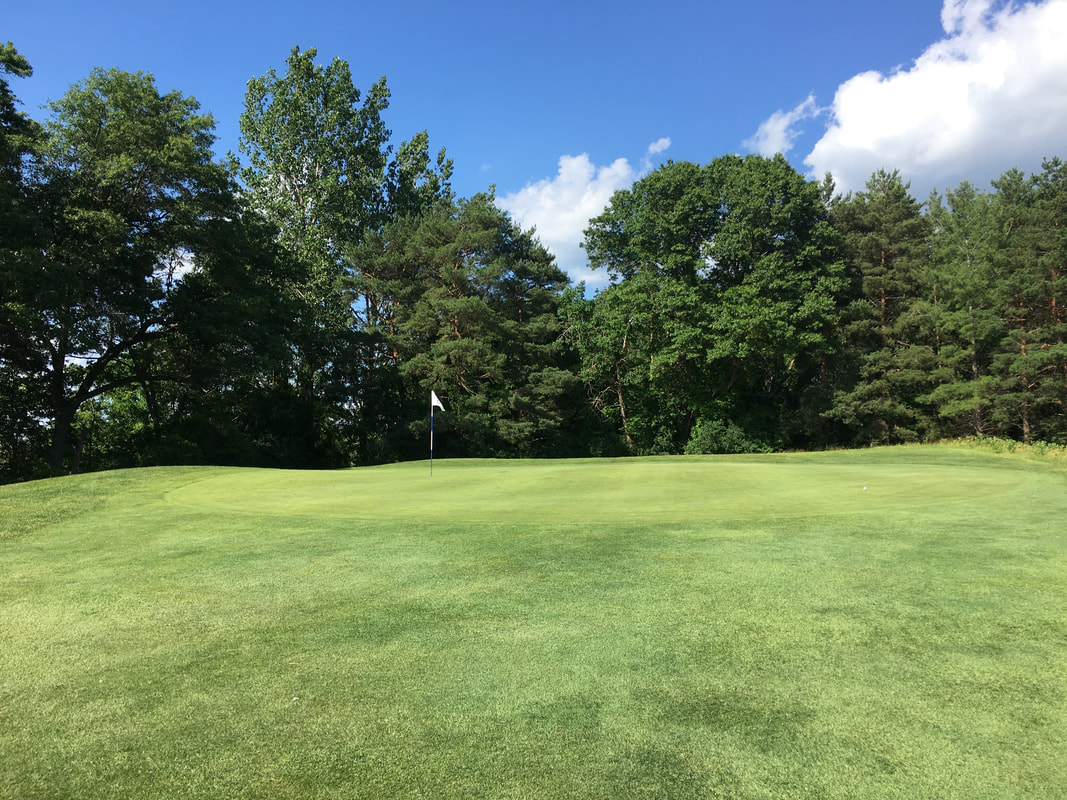

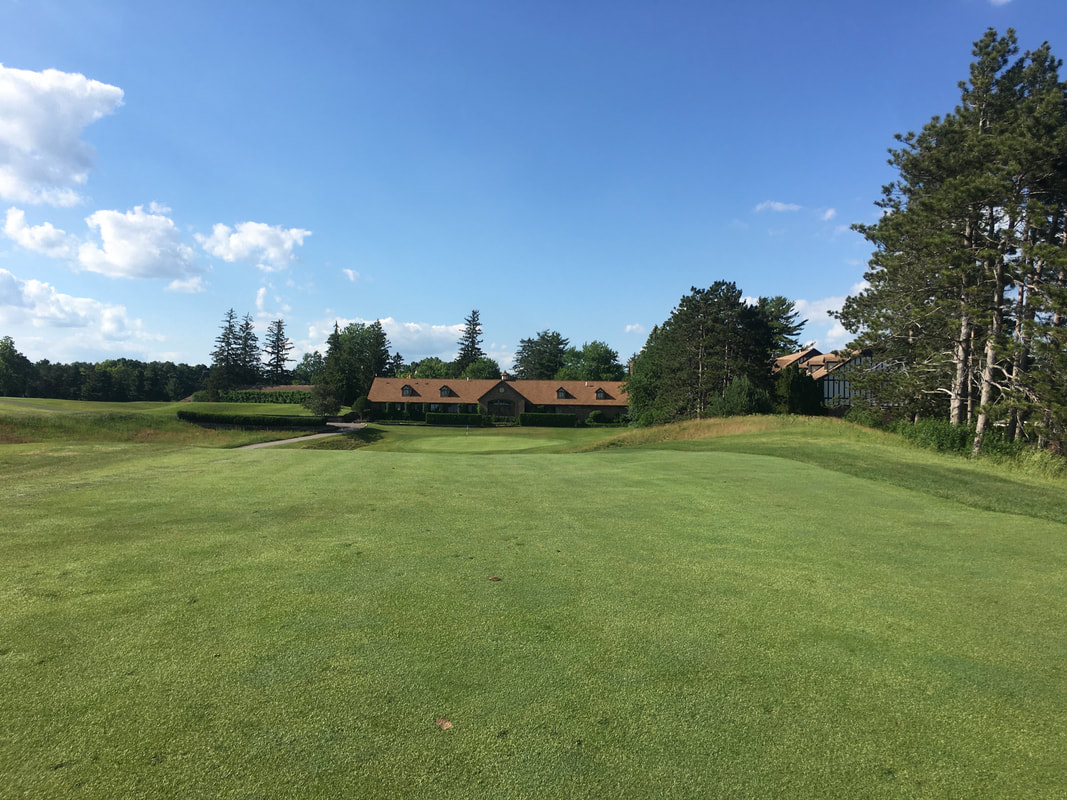















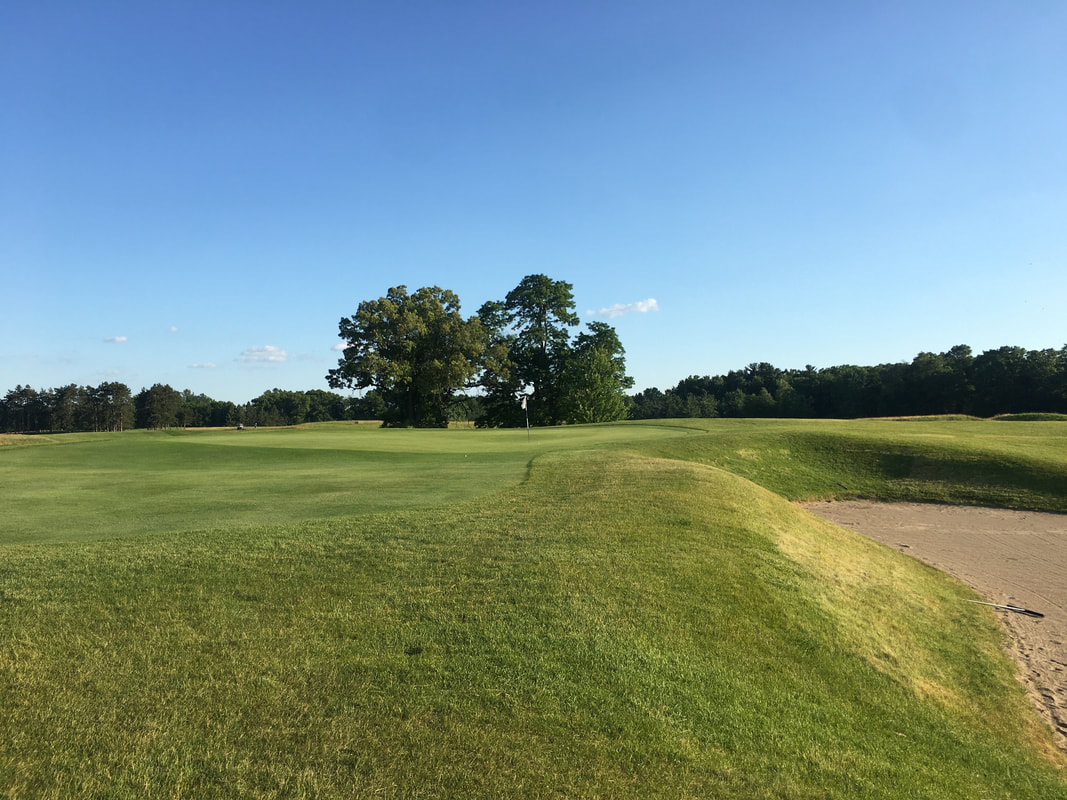

 RSS Feed
RSS Feed